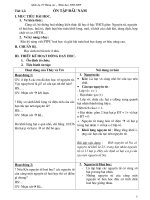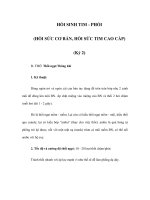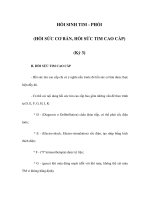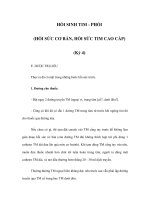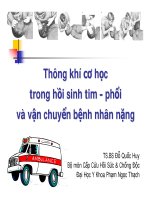Bài giảng hồi sinh tim phổi nâng cao BS hoàng bùi hải
Bạn đang xem bản rút gọn của tài liệu. Xem và tải ngay bản đầy đủ của tài liệu tại đây (1.11 MB, 48 trang )
1
HỒI SINH TIM PHỔI NÂNG CAO
BS. Hoàng Bùi Hải
BM HSCC- ĐHY Hà Nội
HSTP Nâng Cao
ACLS 2010 Guideline
HSTP cơ bản
Ngừng tim
Nhịp nhanh
Nhịp chậm CPR Changes Emphasise
“Push hard, push fast,
minimise interruptions; allow
full chest recoil, and don’t
hyperventilate”
Mất ý thức, ngừng thở hoặc thở ngáp
Hoạt hóa hệ thống cấp cứu
Ép tim
(nhanh, mạnh, thả hết: ép
> 100 l/ph, lún ngực 5
cm)
Lấy máy
sốc điện
Cardiopulmonary Resuscitation and Emergency Cardiovascular CareAdult Basic
Life Support: 2010 American Heart Association Guidelines
2 phút
Kiểm tra
nhịp
Dành cho người
chưa được đào tạo
Có mạch
Không có mạch
Mất ý thức, ngừng thở hoặc thở ngáp
Bắt mạch cảnh 10s
Thổi
ngạt
1
lần/m
ỗi 5-
6s
Khai thông đƣờng thở
Gọi cấp cứu
Ép tim (nhanh, mạnh, giãn tối đa); Ép 100 l/ph
Ép-Thổi
5 chu kỳ
Sốc điện
Máy khử rung tự động (AED)/Máy sốc điện đến
Sốc 1 lần
Không
Có
Cardiopulmonary Resuscitation and
Emergency Cardiovascular CareAdult
Basic Life Support: 2010 American
Heart Association Guidelines
Thổi ngạt 2 lần
2 phút
Dành cho nhân viên y tế
Nguyên lý cơ bản HSTPNC
• To provide critical blood flow to the vital organs with high
quality chest compressions
• Defibrillation as soon as possible provides the best
chance of survival in victims with VF or pulseless VT (cf.
CPR prior to defib)
• Return of spontaneous circulation as rapidly as possible
• Intensive care support aimed to achieve the best
outcomes
HSTPNC – KEY I
• High quality chest compressions with minimal
interruptions; continuing compressions during defibrillator
charging
• Single (non-stacked) shocks, but stacked shocks may be
considered for HPC witnessed arrest*, during cardiac
catheterisation or after cardiac surgery
• Precordial thump is de-emphasised
• IV or IO drug administration (ETT de-emphasised)
*Where a monitor / defibrillator is connected at the time
• Adrenaline 1mg for VF/VT after the second shock once
chest compressions have restarted and then every 3-5
min (alternate blocks of CPR)
• Amiodarone 300mg after third shock
• Atropine no longer recommended for routine use in
asystole or PEA
• Less emphasis on early intubation
• Capnography to confirm and continually monitor tracheal
tube placement, quality of CPR, and to provide early
indication of ROSC
HSTPNC – KEY II
HỒI SỨC SAU NTH
• Recognition that a “post resuscitation care’ protocol may
improve survival following ROSC
• Avoid hyperoxaemia – oxygen titration to S
a
0
2
94-98%
• Primary PCI in appropriate patients with sustained ROSC
• Normoglycaemic glucose control (BSL >10 mmol/l should
be treated but hypoglycaemia avoided)
• Therapeutic hypothermia to include comotose survivors
of cardiac arrest of any rhythm
Single Shock Defibrillation Strategy
• Single shock strategy continues to be recommended to
improve outcome by reducing interruption of chest
compressions
– Monophasic 360J / Biphasic 200 J (Adult)
– Monophasic / Biphasic 4J/kg (Paed)
• Exception is health professional witnessed VF/VT.
– Salvo of three stacked shocks (Mono 360J / Biphasic 200J; with
rhythm checks between shocks)
– Followed by CPR and single shock strategy if unsuccessful
ĐƢỜNG TRUYỀN TĨNH MẠCH
“provision of high-quality CPR and rapid
defibrillation are of primary importance and
drug administration is of secondary
importance”
20ml Bolus after drug
ĐƢỜNG TRUYỀN QUA XƢƠNG
• Reasonable to establish access if IV access
is not readily available
MASK THANH QUẢN
• CPR more important than airway initially
• Put in a supraglottic if intubation is going
to be “hard”
• LMA
• King LT
ĐO CO2 KHÍ THỞ RA
• 100% sensitive and specific for tracheal
intubation
• Helps count 8-10 breaths minute
• Predictor of outcome
KHÔNG Atropin: VÔ TÂM THU
VÀ HĐ ĐIỆN VÔ MẠCH
• “Available evidence suggests that the
routine use of atropine during PEA or
asystole is unlikely to have a therapeutic
benefit”
Thuốc = Máy tạo nhịp
• It hurts!
• No better than drugs
• Ok to go from drugs to TV pacing
• NOT ROUTINE in arrest
TÌM NGUYÊN NHÂN CÓ THỂ
ĐIỀU TRỊ
• 5Hs
• Hypoxia
• Hypovolemia
• Hyperacidosis
• Hyperkalemia
• Hypothemia
• 5Ts
• Thrombus (MI)
• Thrombus (PE)
• Tension PTX
• Toxins
• Tamponade
THUỐC CO MẠCH
• VF continues after epi and CPR -
vasopressor
• Amiodarone is first line
• Not proven to result in long term outcome
• Lidocaine is useless also
Epinephrine
• Never any evidence that it works!
• A Randomized placebo controlled trial of adrenaline in
cardiac arrest- the PACA trial
• Conclusion: The use of adrenaline in cardiac arrest was
associated w significant increase in the proportion of pts
achieving ROSC however this improvement did not extend
to survival to hospital discharge.
Tóm lại- với Ngừng tim
• Atropine OUT for PEA/Asystole
• CPR first and fast
• Airway- supraglottic emerges
• Still have amiodarone even though it don’t work
• Hope lies in a reversible cause
NHỊP NHANH
1. Pearl 1: Don’t cardiovert to sinus rhythm
2. Pearl 2: Rates<150 don’t usually cause instability in
normal healthy hearts
3. Pearl 3: Many arrhythmias caused by hypoxia- Fix
that first
4. Pearl 4: If unstable use electricity- except narrow
complex when adenosine may be ok
5. Pearl 5: IF THEY ARE PRETTY STABLE - GET A 12
LEAD ECG
Nhịp nhanh – 5 nguyên tắc

